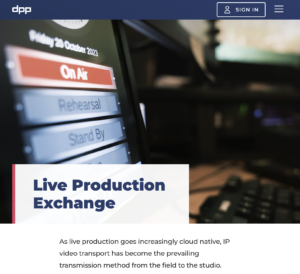Categories
Archives
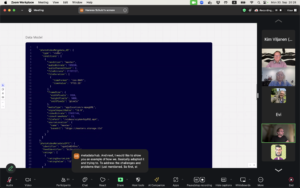
The IPTC Video Metadata Working Group has released version 1.6 of its Video Metadata Hub standard, including terms for rights usage, language, and content created by Generative AI models.
New properties
-
Rights Usage Terms: The licensing parameters of the video expressed in free text. (Aligned with the equivalent term in IPTC Photo Metadata.)
Changed properties
-
Language: Changed label and description to reflect that this represents the main language of the video. (Previously the term was called “language version”).
-
Source (Supply Chain): Changed description to reflect that changes made be made by a system (such as a Generative AI engine) as well as a person or organisation.
The specification for Video Metadata Hub is separated into two parts: IPTC Video Metadata Hub properties and IPTC Video Metadata Hub mappings showing how to apply these core properties in many existing video standards.
There is also a JSON Schema representation of Video Metadata Hub, which is used by some large media companies in manageing their video content. The 1.6 version of the JSON schema reflects the latest changes.
The Video Metadata Hub User Guide and Video Metadata Hub Generator tool have also been updated to include the changes in version 1.6.
Please feel free to discuss the new version of Video Metadata Hub on the public iptc-videometadata discussion group, or contact IPTC via the Contact us form.
The latest version of NewsML-G2, version 2.35 has been released, adding support for the status of events.
Approved by the IPTC Standards Committee at the IPTC Spring Meeting, on 16th May, the new version adds a property eventStatus which matches the equivalent property in ninjs that was added in version 3.0.
eventStatus, within the eventDetails block, describes the status of an actual event – as opposed to occurenceStatus, which conveys the status of how likely it is that a future event will occur, and coverageStatus, which conveys the planned news coverage of a news event.
The recommended controlled vocabulary for eventStatus is http://cv.iptc.org/newscodes/eventstatus, which currently contains the terms “scheduled“, “in progress“, “completed“, “postponed” and “canceled“.
IPTC Catalog updated to version 41
The IPTC Catalog, the master list of internally- and externally-managed controlled vocabularies used and referenced by NewsML-G2, has been updated to version 41. It adds the PLUS Licence Data Format vocabulary, used extensively in IPTC Photo Metadata and now in other standards through the introduction of the Data Mining vocabulary.
The latest catalog is available at http://iptc.org/std/catalog/catalog.IPTC-G2-Standards_41.xml (note the plain http URL scheme. We don’t link directly to it here because clicking the link may trigger browser warnings about moving from https to http URLs.)
Find out more about NewsML-G2 2.35
All information related to NewsML-G2 2.35 is at https://iptc.org/std/NewsML-G2/2.35/.
The NewsML-G2 Specification document has been updated to cover the new version 2.35.
Example instance documents are at https://iptc.org/std/NewsML-G2/2.35/examples/.
Full XML Schema documentation is located at https://iptc.org/std/NewsML-G2/2.35/specification/XML-Schema-Doc-Power/
XML source documents and unit tests are hosted in the public NewsML-G2 GitHub repository.
The NewsML-G2 Generator tool has also been updated to produce NewsML-G2 2.35 files using the version 41 catalog.
For any questions or comments, please contact us via the IPTC Contact Us form or post to the iptc-newsml-g2@groups.io mailing list. IPTC members can ask questions at the weekly IPTC News Architecture Working Group meetings.
For more information, contact the IPTC News Architecture Working Group via the public NewsML-G2 mailing list.
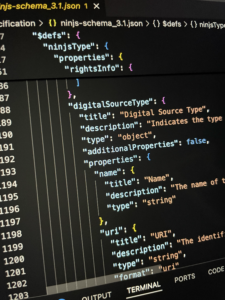
The IPTC is excited to announce the latest updates to ninjs, our JSON-based standard for representing news content metadata. Version 3.1 is now available, along with updated versions 2.2 and 1.6 for those using earlier schemas.
These releases reflect IPTC’s ongoing commitment to supporting structured, machine-readable news content across a variety of technical and editorial workflows.
What is ninjs?
ninjs (News in JSON) is a flexible, developer-friendly format for describing news items in a structured way. It allows publishers, aggregators, and news tech providers to encode rich metadata about articles, images, videos, and more, using a clean JSON format that fits naturally into modern content pipelines.
What’s new in ninjs 3.1, 2.2 and 1.6?
The new releases add a new property for the IPTC Digital Source Type property, which was first used with the IPTC Photo Metadata Standard but now used across the industry to declare the source of media content, including content generated or manipulated by a Generative AI engine.
The new property (called digitalSourceType in 3.1 and digitalsourcetype in 2.2 and 1.6 to match the case conventions of each standard version) has the following properties:
- Name: the name of the digital source type, such as “Created using Generative AI”
- URI: the official identifier of the digital source type from the IPTC Digital Source Type vocabulary or another vocabulary, such as http://cv.iptc.org/newscodes/digitalsourcetype/trainedAlgorithmicMedia (the official ID for generative AI content)
- Literal: an optional way to add new digital source types that are not part of a controlled vocabulary.
IPTC supports multiple versions of ninjs in parallel to ensure stability and continuity for publishers and platforms that depend on long-term schema support.
The new property is part of the general ninjs schema, and so can be used in the main body of a ninjs object to describe the main news item and can also be used in an “association” object which refers to an associated media item.
Access the schemas
All versions are publicly available on the IPTC website:
ninjs generator and user guide
The ninjs Generator tool has been updated to cover the latest versions. Fill in the form fields and see what that content looks like in ninjs format. You can switch between the schema versions to see how the schema changes between 1.6, 2.2 and 3.1.
The ninjs User Guide has also been updated to reflect the newly added property.
Why it matters
As the news industry becomes increasingly reliant on metadata for content distribution, discoverability, and rights management, ninjs provides a modern, extensible foundation that supports both human and machine workflows. It’s trusted by major news agencies, technology platforms, and AI developers alike.
Get involved
We welcome feedback from the community and encourage you to share how you’re using ninjs in your own products or platforms. If you would like to discuss ninjs, you can join the public mailing list at https://groups.io/g/iptc-ninjs.
If you’re interested in contributing to the development of IPTC standards, join us!
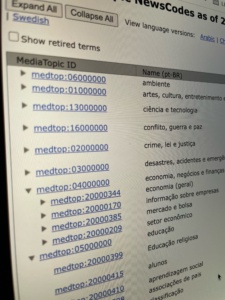
The IPTC NewsCodes Working Group is pleased to present the Q1 2025 release of IPTC NewsCodes.
As usual, most of the updates are in our flagship subject vocabulary, Media Topics.
Media Topic updates
This release adds 8 new concepts, retires 17 concepts, modifies 43 label names and 64 definitions, adds 10 notes (mostly to retired concepts), makes 28 hierarchy moves and modifies 7 wikidata mappings.
The new and modified terms have already been translated into Swedish (lang=se) and Norwegian (lang=no-NB and lang=no-NN)
New concepts (8 terms)
zoning policy, political party, political movement and association, communism, democratic socialism, theocracy, absolute monarchy, ski mountaineering
Note that ski mountaineering (medtop:20001390) has been added to the Media Topics vocabulary because it was added as a new sport for the 2026 Olympics.
Retired concepts (17 terms)
- civil and public service – use government employee (medtop:20000595) instead.
- military equipment – use military weaponry and equipment (medtop:20000602) instead.
- security measures (defence) – use national security (medtop:20000598) instead.
- national security (old) – Use national security (medtop:20000598) instead.
- public finance – Use government budget (medtop:20000607) or government debt (medtop:20000368) instead.
- government department – Use more specific terms or government (medtop:20000593) instead.
- safety of citizens – Use other terms such as public health (medtop:20001358) or emergency response (medtop:20000168) instead.
- interior policy – Use more specific terms instead.
- personal data collection policy – Use data protection policy (medtop:20000627) instead.
- planning inquiries – Use zoning policy (medtop:20001383), environmental policy (medtop:20000423) or other more specific terms instead.
- political crisis – Use more specific terms instead.
- political process – Use government (medtop:20000593) or other more specific terms instead.
- political parties and movements – Use political party (medtop:20001384) or political movement and association (medtop:20001385) instead.
- political development – Use politics (medtop:11000000) instead.
- civilian service – Use medtop:20001277 volunteering instead.
- integration policy – Use immigration policy (medtop:20000634) instead.
- regulatory authority – Use regulation of industry (medtop:20000636) instead.
Modified labels (43 terms)
politics and government, demonstration, government employee, public officials, constitution (law).
national security.military weaponry and equipment, head of state,local authority, minister or secretary (government), regional authority, taxation policy, data protection policy, immigration policy, summit meeting, treaty, foreign aid, international organisation, refugees and internally displaced people, non-governmental organisation (NGO), political prisoners and dissenters, cultural policy, sports policies, political party convention, political committee, head of government, border dispute, financial service, corporate bond, war victims, missing in action, breaking (breakdance), by-election, recall election, coalition building, zoning policy, political party, political movement and association, communism, democratic socialism, theocracy, absolute monarchy, ski mountaineering.
Modified definitions (64 terms)
politics and government, demonstration, computer networking, economic policy, environmental policy, healthcare policy, government, government employee, public officials, constitution (law), national security, armed forces, military weaponry and equipment, executive (government), government budget, head of state, local authority, minister or secretary (government), regional authority, taxation policy, government policy, nationalisation, privatisation, state-owned enterprise, data protection policy, policy towards indigenous people, pension and welfare policy, personal weapon control policy, immigration policy, nuclear policy, regulation of industry, food and drink regulations, international relations, diplomacy, summit meeting, treaty, economic sanction, foreign aid, international organisation, refugees and internally displaced people, non-governmental organisation (NGO), political prisoners and dissenters, lobbying, political system, democracy, dictatorship, cultural policy, sports policies, regional development policy, political party convention, head of government, infrastructure policy, economic development incentive, political leadership, border dispute, education policy, zoning policy, political party, political movement and association, communism, democratic socialism, theocracy, absolute monarchy, ski mountaineering.
Modified notes (10 terms)
safety of citizens, interior policy, personal data collection policy, planning inquiries, political crisis, political process, political parties and movements, political development, civilian service, integration policy.
Modified broader terms (hierarchy moves) (28 terms)
campaign finance, government employee, public officials, military weaponry and equipment, espionage and intelligence, data protection policy, housing and urban planning policy, policy towards indigenous people, pension and welfare policy, personal data collection policy, personal weapon control policy, planning inquiries, lobbying, political parties and movements, political development, political system, integration policy, regional development policy, infrastructure policy, political leadership, zoning policy, political party, political movement and association, communism, democratic socialism, theocracy, absolute monarchy, ski mountaineering.
Modified wikidata mappings: 7
political party, political movement and association, communism, democratic socialism, theocracy, absolute monarchy, ski mountaineering.
See the official Media Topic vocabulary on the IPTC Controlled Vocabulary server, and an easier-to-navigate tree view. An Excel version of IPTC Media Topics is also available.
Non-Media Topic changes
- New term: Software
- New terms: anonymised, recommended anonymisation
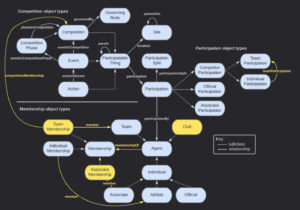
The IPTC Sports Content Working Group is proud to release version 1.1 of IPTC Sport Schema.
Documented at the dedicated site sportschema.org, Sport Schema is IPTC’s semantic web (RDF) based ontology for describing sports listings, results, statistics and even play-by-play actions during any kind of sports event.
Version 1.1 adds the following new features:
- We add a Club type, which can handle the organisation that hosts one or more teams of varying types, possibly across various sports. (Did you know that Bayern Munich has not just the famous men’s, women’s and junior football/soccer teams, but also basketball, handball, table tennis and even chess teams!)
- We also add a TeamMembership type, so a Team can be a member of a Club (and could theoretically move from one Club to another).
- We add support for the concept of “sports facets” that we originated in SportsML. (based on SportsML / NewsCodes facets) so we can now say that an event is “women’s 400 metres relay swimming”, not just “swimming”. The boxing example shows that the weight class of the event is “welterweight”.
- Added the ability to link from Athlete to Team via a new teamParticipation property.
- Add an AssociateMembership type so an Associate (such as a coach) can have a tenure relating to any Agent, including an Athlete or a Team. Previously Associates were linked to Teams via Participation objects which wasn’t satisfactory.
- Expanded and added to examples including a Boxing example showing how the new AssociateMembership type can be used to represent a coach or manager of an individual athlete (in this case a boxer)
- Added new golf ontology taking some properties from SportsML and some from the Golf vocabularies in IPTC NewsCodes. We have merged them together in Sport Schema for ease of use.
- Many cleanups to the SHACL Shapes used for validation of data.
Please take a look at Sport Schema and let us know what you think! We would love to hear about Sport Schema being implemented in real-world projects. Please contact IPTC using the Contact Us form or via the public discussion list at groups.io/g/iptc-sportsml/
At the IPTC Autumn Meeting, the IPTC Standards Committee voted on a change proposed by the Photo Metadata Working Group, which created version 2024.1 of the IPTC Photo Metadata Standard.
The change is minor but important to some: the definition of the Keywords property now includes the following text:
Keywords to express the subject and other aspects of the content of the image. Keywords may be free text and don’t have to be taken from a controlled vocabulary. Codes from the controlled vocabulary IPTC Subject NewsCodes must go to the “Subject Code” field.
This aligns the property definition with the way in which many photo agencies and photographers were already using the field: to convey aspects such as the lighting or lens effects used, “mood” of the image, dominant colour and more.
We give examples of how the Keywords property may be used in the IPTC Photo Metadata User Guide.
The relevant files have all been updated for the new version:
- The IPTC Photo Metadata Standard Specification
- The IPTC Photo Metadata User Guide
- The IPTC Photo Metadata TechReference, in both YAML and JSON formats
- The IPTC Photo Metadata Reference Image
We thank Agence France-Presse for their help in offering examples for how the Keywords property may be used.
The IPTC has worked together with the DPP and stakeholders from Reuters, Arqiva and Warner Brothers Discovery to develop a pioneering new initiative called DPP Live Production Exchange (LPX). The LPX protocol covers API and a data schema for information related to news coverage of live events, including the ability for B2B event subscribers to be informed about upcoming news events and their coverage.
IPTC’s contribution to the project was to enhance and evolve our ninjs (News in JSON) standard to support news coverage of events and live streamed content. The News in JSON Working Group dedicated a lot of its time to this work over the past two years, including participating in the DPP LPX Hackathon in Spring 2024.
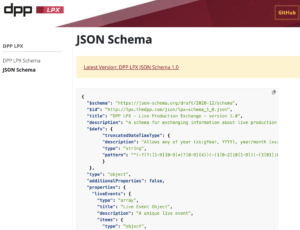
The underlying data model for the events and planning work in ninjs comes from the IPTC News Architecture and is based on EventsML-G2, a part of the NewsML-G2 family of standards which was created over 10 years ago.
Ian Young of PA Media, Lead of the IPTC News in JSON Working Group, said “Basing the work of ninjs 3.0 on the stable foundation of the IPTC News Architecture made our work much simpler. IPTC members have been syndicating news events for years using this model so we know that it works. That meant that we could focus on making ninjs 3.0 handle live events and streaming video in a way that is practical and simple, both for developers and for users.”
IPTC Managing Director Brendan Quinn said “we owe our thanks to our teammates and partners on this project: David Thompson from IPTC liaison partners the DPP, JJ Eynon from CNN / Warner Brothers Discovery, Tania Vivero and Ian McLaren from Reuters (IPTC Voting Member), and Daniel Lynch from Arqiva (IPTC Associate Member). Through a very friendly and collegial but also productive and results-driven collaboration, we have arrived at a solution that should make syndicated news events much easier to handle in all newsroom workflows.”
ninjs 3.0 and the LPX API are or will soon be supported by tools from Arqiva, Reuters and Wolftech (who were recently acquired by Avid). We hope that many more implementations will be emerge in the coming months.
For more on ninjs 3.0, see the following resources:
- IPTC’s pages on ninjs (News in JSON)
- The ninjs generator tool, a simple form that generates sample ninjs documents in versions 1.5, 2.1 and 3.0
- The IPTC’s ninjs GitHub repository
- IPTC members regularly discuss ninjs at our News in JSON Working Group meetings and on the members-only News in JSON WG discussion group.
- Non-members are welcome to discuss ninjs at the public ninjs discussion group.

The IPTC NewsCodes Working Group is pleased to announce the latest release of the IPTC NewsCodes, our set of controlled vocabularies for the news industry.
Updates this time span many vocabularies, with the biggest updates to Media Topic and Digital Source Type.
Media Topic updates
Most of the recent work has been in the politics branch.
3 new concepts: by-election, recall election, coalition building
2 retired concepts: political campaigns, church elections
4 modified concept names (in English): voting system, referendum, fundamental rights, football (yes we finally refer to the sport as “football” in en-GB and “soccer” in en-US!)
Modified concept definitions: 22 civil rights, election, voting system, intergovernmental elections, local elections, primary elections, referendum, regional elections, voting, fundamental rights, censorship and freedom of speech, freedom of religion, freedom of the press, human rights, football, political debates, privacy, women’s rights, breaking (breakdance)
1 hierarchy move: fundamental rights has been moved from politics to society.
Also, the Wikidata mapping URIs have all been changed to point to the http:// version of the URI instead of the https:// version. This follows the official Wikidata guidance.
See the official Media Topic vocabulary on the IPTC Controlled Vocabulary server, and an easier-to-navigate tree view. An Excel version of IPTC Media Topics is also available.
Digital Source Type updates
5 new concepts have been added:
- Multi-frame computational capture sampled from real life, intended to cover media recorded by modern cameras and smartphones that may process several captured images together to create the saved media file, without any interaction with the photographer.
- Human-edited media, intended to replace the retired Original media with minor human edits, given that it is subjective to decide what is a “minor” edit.
- Digital creation, intended to replace the retired Digital art so that we can avoid the existential question of “what is art?”
- Screen capture, covering screenshots and screen recordings made on a device
- Composite of elements, as a generic form of the more specific “composite” terms.
2 concepts have been retired: Original media with minor human edits, and Digital art, as explained above.
8 concepts have had their names and definitions modified, while retaining the same machine-readable ID for backwards-compatibility purposes:
- Digital capture sampled from real life (ID: digitalCapture), replacing the previous name “Original digital capture sampled from real life”
- Digitised from a transparent negative (ID: negativeFilm), replacing the previous name “Digitised from a negative on film”
- Digitised from a transparent positive (ID: positiveFilm), replacing the previous name “Digitised from a positive on film”
- Digitised from a non-transparent medium (ID: print), replacing the previous name “Digitised from a print on non-transparent medium”
- Edited using Generative AI (ID: compositeWithTrainedAlgorithmicMedia), replacing the previous name “Composite with Trained algorithmic media”
- Algorithmically-altered media (ID: algorithmicallyEnhanced), replacing the previous name “Algorithmically Enhanced”
- Created using Generative AI (ID: trainedAlgorithmicMedia), replacing the previous name “Trained Algorithmic Media”
- Virtual event recording (ID: virtualRecording), replacing the previous name “Virtual recording”
Our thanks go to IPTC representatives and experts from Partnership on AI, Google, Adobe, C2PA, CIPA and many others on making these updates to our vocabulary, which is now widely used to identify Generative AI content.
Updates to other NewsCodes vocabularies
Alternative Identifier Role (altidrole)
- Vocabulary’s name changed to fix a spelling mistake.
- New concept: IPTC Video Metadata Hub ID (altidrole:vmhVideoId)
Event Occur Status (eocstat)
- Fix spelling mistake “occurence” -> “occurrence” throughout.
Golf Shot (spgolshot)
- New concept: Chip (spgolshot:chip)
Rights Property (rightsprop)
- New concept: Copyright Year (rightsprop:copyrightyear)
- 4 modified definitions: Minor Model Age Disclosure, Model Release Id, Model Release Status, Property Release Status.
Sports Concept (spct)
- New concept: Recurring Competition (spct:recurring-competition)
- New concept: Governing Body (spct:governing-body)
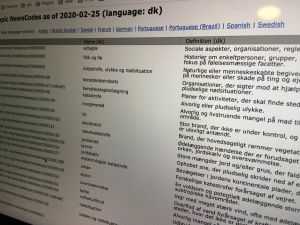 The IPTC NewsCodes Working Group has released the latest update to IPTC NewsCodes vocabularies.
The IPTC NewsCodes Working Group has released the latest update to IPTC NewsCodes vocabularies.
The changes are quite minor this time, but we still recommend that users stay up to date with the latest version.
Changes to Media Topics vocabulary
Our main subject classification taxonomy, IPTC Media Topics, has seen the following updates:
1 new concept
- breaking (breakdance) (added earlier this year in time for the Paris 2024 Olympics)
1 retired concept
- missing in action (duplicate term added in error in the 2024 Q1 update. The existing term missing in action medtop:20000061 was moved to replace the newer term))
32 modified definitions
These changes mostly correct spelling errors in en-GB where US spellings had slipped in, such as changing “behavior” to “behaviour” for en-GB:
wireless technology, tobacco and nicotine, economic trends and indicators, international economic institution, stocks and securities, adult and continuing education, upper secondary education, social learning, medical condition, Confucianism, relations between religion and government, road cycling, competitive dancing, sexual misconduct, developmental disorder, fraternal and community group, cyber warfare, public transport, taxi and ride-hailing, shared transport, business reporting and performance, business restructuring, commercial real estate, residential real estate, podcast, financial service, business service, news industry, diversity, equity and inclusion, sustainability, profit sharing, breaking (breakdance).
As usual, the Media Topics vocabularies can be viewed in the following ways:
- In a collapsible tree view
- As a downloadable Excel spreadsheet
- On one page on the cv.iptc.org server
- In machine readable formats such as RDF/XML and Turtle using the SKOS vocabulary format: see the cv.iptc.org guidelines document for more detail.
Updates to other vocabularies
Horse Position (sphorposition)
New term “trainer” added to https://cv.iptc.org/newscodes/sphorposition. This term is needed by IPTC Sport Schema.
For more information on IPTC NewsCodes in general, please see the IPTC NewsCodes Guidelines.
The IPTC News Architecture Working Group is happy to announce the release of NewsML-G2 version 2.34.
This version, approved at the IPTC Standards Committee Meeting at the New York Times offices on Wednesday 17th April 2024, contains one small change and one additional feature:
Change Request 218, increase nesting of <related> tags: this allows for <related> items to contain child <related> items, up to three levels of nesting. This can be applied to many NewsML-G2 elements:
- pubHistory/published
- QualRelPropType (used in itemClass, action)
- schemeMeta
- ConceptRelationshipsGroup (used in concept, event, Flex1PropType, Flex1RolePropType, FlexPersonPropType, FlexOrganisationPropType, FlexGeoAreaPropType, FlexPOIPropType, FlexPartyPropType, FlexLocationPropType)
Note that we chose not to allow for recursive nesting because this caused problems with some XML code generators and XML editors.
Change Request 219, add dataMining element to rightsinfo: In accordance with other IPTC standards such as the IPTC Photo Metadata Standard and Video Metadata Hub, we have now added a new element to the <rightsInfo> block to convey a content owner’s wishes in terms of data mining of the content. We recommend the use of the PLUS Vocabulary that is also recommended for the other IPTC standards: https://ns.useplus.org/LDF/ldf-XMPSpecification#DataMining
Here are some examples of its use:
Denying all Generative AI / Machine Learning training using this content:
<rightsInfo> <dataMining uri="http://ns.useplus.org/ldf/vocab/DMI-PROHIBITED-AIMLTRAINING"/> </rightsInfo>
A simple text-based constraint:
<rightsInfo> <usageTerms> Data mining allowed for academic and research purposes only. </usageTerms> <dataMining uri="http://ns.useplus.org/ldf/vocab/DMI-PROHIBITED-SEECONSTRAINT" /> </rightsInfo>
A simple text based constraint, expressed using a QCode instead of a URI:
<rightsInfo> <usageTerms> Reprint rights excluded. </usageTerms> <dataMining qcode="plusvocab:DMI-PROHIBITED-SEECONSTRAINT" /> </rightsInfo>
A text-based constraint expressed in both English and French:
<rightsInfo> <usageTerms xml:lang="en"> Reprint rights excluded. </usageTerms> <usageTerms xml:lang="fr"> droits de réimpression exclus </usageTerms> <dataMining uri="http://ns.useplus.org/ldf/vocab/DMI-PROHIBITED-SEECONSTRAINT" /> </rightsInfo>
Using the “see embedded rights expression” constraint to express a complex machine-readable rights expression in RightsML:
<rightsInfo>
<rightsExpressionXML langid="http://www.w3.org/ns/odrl/2/">
<!-- RightsML goes here... -->
</rightsExpressionXML>
<dataMining uri="http://ns.useplus.org/ldf/vocab/DMI-PROHIBITED-SEEEMBEDDEDRIGHTSEXPR"/>>
</rightsInfo>
For more information, contact the IPTC News Architecture Working Group via the public NewsML-G2 mailing list.
